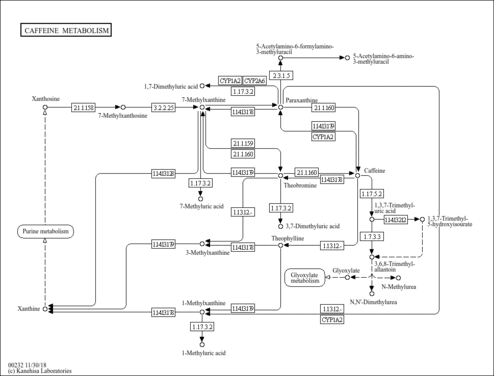| 5-Acetylamino-6-formylamino-3-methyluracil,1TMS,isomer #1 | CC(=O)NC1=C(NC=O)N([Si](C)(C)C)C(=O)N(C)C1=O | 2123.2 | Semi standard non polar | 33892256 |
| 5-Acetylamino-6-formylamino-3-methyluracil,1TMS,isomer #1 | CC(=O)NC1=C(NC=O)N([Si](C)(C)C)C(=O)N(C)C1=O | 2275.1 | Standard non polar | 33892256 |
| 5-Acetylamino-6-formylamino-3-methyluracil,1TMS,isomer #1 | CC(=O)NC1=C(NC=O)N([Si](C)(C)C)C(=O)N(C)C1=O | 4237.0 | Standard polar | 33892256 |
| 5-Acetylamino-6-formylamino-3-methyluracil,1TMS,isomer #2 | CC(=O)NC1=C(N(C=O)[Si](C)(C)C)[NH]C(=O)N(C)C1=O | 2114.0 | Semi standard non polar | 33892256 |
| 5-Acetylamino-6-formylamino-3-methyluracil,1TMS,isomer #2 | CC(=O)NC1=C(N(C=O)[Si](C)(C)C)[NH]C(=O)N(C)C1=O | 2257.3 | Standard non polar | 33892256 |
| 5-Acetylamino-6-formylamino-3-methyluracil,1TMS,isomer #2 | CC(=O)NC1=C(N(C=O)[Si](C)(C)C)[NH]C(=O)N(C)C1=O | 3958.6 | Standard polar | 33892256 |
| 5-Acetylamino-6-formylamino-3-methyluracil,1TMS,isomer #3 | CC(=O)N(C1=C(NC=O)[NH]C(=O)N(C)C1=O)[Si](C)(C)C | 2062.9 | Semi standard non polar | 33892256 |
| 5-Acetylamino-6-formylamino-3-methyluracil,1TMS,isomer #3 | CC(=O)N(C1=C(NC=O)[NH]C(=O)N(C)C1=O)[Si](C)(C)C | 2202.0 | Standard non polar | 33892256 |
| 5-Acetylamino-6-formylamino-3-methyluracil,1TMS,isomer #3 | CC(=O)N(C1=C(NC=O)[NH]C(=O)N(C)C1=O)[Si](C)(C)C | 3649.1 | Standard polar | 33892256 |
| 5-Acetylamino-6-formylamino-3-methyluracil,2TMS,isomer #1 | CC(=O)N(C1=C(NC=O)N([Si](C)(C)C)C(=O)N(C)C1=O)[Si](C)(C)C | 2057.9 | Semi standard non polar | 33892256 |
| 5-Acetylamino-6-formylamino-3-methyluracil,2TMS,isomer #1 | CC(=O)N(C1=C(NC=O)N([Si](C)(C)C)C(=O)N(C)C1=O)[Si](C)(C)C | 2250.0 | Standard non polar | 33892256 |
| 5-Acetylamino-6-formylamino-3-methyluracil,2TMS,isomer #1 | CC(=O)N(C1=C(NC=O)N([Si](C)(C)C)C(=O)N(C)C1=O)[Si](C)(C)C | 3111.4 | Standard polar | 33892256 |
| 5-Acetylamino-6-formylamino-3-methyluracil,2TMS,isomer #2 | CC(=O)NC1=C(N(C=O)[Si](C)(C)C)N([Si](C)(C)C)C(=O)N(C)C1=O | 2103.9 | Semi standard non polar | 33892256 |
| 5-Acetylamino-6-formylamino-3-methyluracil,2TMS,isomer #2 | CC(=O)NC1=C(N(C=O)[Si](C)(C)C)N([Si](C)(C)C)C(=O)N(C)C1=O | 2390.3 | Standard non polar | 33892256 |
| 5-Acetylamino-6-formylamino-3-methyluracil,2TMS,isomer #2 | CC(=O)NC1=C(N(C=O)[Si](C)(C)C)N([Si](C)(C)C)C(=O)N(C)C1=O | 3505.9 | Standard polar | 33892256 |
| 5-Acetylamino-6-formylamino-3-methyluracil,2TMS,isomer #3 | CC(=O)N(C1=C(N(C=O)[Si](C)(C)C)[NH]C(=O)N(C)C1=O)[Si](C)(C)C | 1961.3 | Semi standard non polar | 33892256 |
| 5-Acetylamino-6-formylamino-3-methyluracil,2TMS,isomer #3 | CC(=O)N(C1=C(N(C=O)[Si](C)(C)C)[NH]C(=O)N(C)C1=O)[Si](C)(C)C | 2246.7 | Standard non polar | 33892256 |
| 5-Acetylamino-6-formylamino-3-methyluracil,2TMS,isomer #3 | CC(=O)N(C1=C(N(C=O)[Si](C)(C)C)[NH]C(=O)N(C)C1=O)[Si](C)(C)C | 2917.8 | Standard polar | 33892256 |
| 5-Acetylamino-6-formylamino-3-methyluracil,3TMS,isomer #1 | CC(=O)N(C1=C(N(C=O)[Si](C)(C)C)N([Si](C)(C)C)C(=O)N(C)C1=O)[Si](C)(C)C | 2038.0 | Semi standard non polar | 33892256 |
| 5-Acetylamino-6-formylamino-3-methyluracil,3TMS,isomer #1 | CC(=O)N(C1=C(N(C=O)[Si](C)(C)C)N([Si](C)(C)C)C(=O)N(C)C1=O)[Si](C)(C)C | 2350.7 | Standard non polar | 33892256 |
| 5-Acetylamino-6-formylamino-3-methyluracil,3TMS,isomer #1 | CC(=O)N(C1=C(N(C=O)[Si](C)(C)C)N([Si](C)(C)C)C(=O)N(C)C1=O)[Si](C)(C)C | 2604.2 | Standard polar | 33892256 |
| 5-Acetylamino-6-formylamino-3-methyluracil,1TBDMS,isomer #1 | CC(=O)NC1=C(NC=O)N([Si](C)(C)C(C)(C)C)C(=O)N(C)C1=O | 2371.0 | Semi standard non polar | 33892256 |
| 5-Acetylamino-6-formylamino-3-methyluracil,1TBDMS,isomer #1 | CC(=O)NC1=C(NC=O)N([Si](C)(C)C(C)(C)C)C(=O)N(C)C1=O | 2516.8 | Standard non polar | 33892256 |
| 5-Acetylamino-6-formylamino-3-methyluracil,1TBDMS,isomer #1 | CC(=O)NC1=C(NC=O)N([Si](C)(C)C(C)(C)C)C(=O)N(C)C1=O | 4079.4 | Standard polar | 33892256 |
| 5-Acetylamino-6-formylamino-3-methyluracil,1TBDMS,isomer #2 | CC(=O)NC1=C(N(C=O)[Si](C)(C)C(C)(C)C)[NH]C(=O)N(C)C1=O | 2369.2 | Semi standard non polar | 33892256 |
| 5-Acetylamino-6-formylamino-3-methyluracil,1TBDMS,isomer #2 | CC(=O)NC1=C(N(C=O)[Si](C)(C)C(C)(C)C)[NH]C(=O)N(C)C1=O | 2467.6 | Standard non polar | 33892256 |
| 5-Acetylamino-6-formylamino-3-methyluracil,1TBDMS,isomer #2 | CC(=O)NC1=C(N(C=O)[Si](C)(C)C(C)(C)C)[NH]C(=O)N(C)C1=O | 3956.3 | Standard polar | 33892256 |
| 5-Acetylamino-6-formylamino-3-methyluracil,1TBDMS,isomer #3 | CC(=O)N(C1=C(NC=O)[NH]C(=O)N(C)C1=O)[Si](C)(C)C(C)(C)C | 2316.5 | Semi standard non polar | 33892256 |
| 5-Acetylamino-6-formylamino-3-methyluracil,1TBDMS,isomer #3 | CC(=O)N(C1=C(NC=O)[NH]C(=O)N(C)C1=O)[Si](C)(C)C(C)(C)C | 2416.6 | Standard non polar | 33892256 |
| 5-Acetylamino-6-formylamino-3-methyluracil,1TBDMS,isomer #3 | CC(=O)N(C1=C(NC=O)[NH]C(=O)N(C)C1=O)[Si](C)(C)C(C)(C)C | 3559.2 | Standard polar | 33892256 |
| 5-Acetylamino-6-formylamino-3-methyluracil,2TBDMS,isomer #1 | CC(=O)N(C1=C(NC=O)N([Si](C)(C)C(C)(C)C)C(=O)N(C)C1=O)[Si](C)(C)C(C)(C)C | 2536.6 | Semi standard non polar | 33892256 |
| 5-Acetylamino-6-formylamino-3-methyluracil,2TBDMS,isomer #1 | CC(=O)N(C1=C(NC=O)N([Si](C)(C)C(C)(C)C)C(=O)N(C)C1=O)[Si](C)(C)C(C)(C)C | 2680.0 | Standard non polar | 33892256 |
| 5-Acetylamino-6-formylamino-3-methyluracil,2TBDMS,isomer #1 | CC(=O)N(C1=C(NC=O)N([Si](C)(C)C(C)(C)C)C(=O)N(C)C1=O)[Si](C)(C)C(C)(C)C | 3068.2 | Standard polar | 33892256 |
| 5-Acetylamino-6-formylamino-3-methyluracil,2TBDMS,isomer #2 | CC(=O)NC1=C(N(C=O)[Si](C)(C)C(C)(C)C)N([Si](C)(C)C(C)(C)C)C(=O)N(C)C1=O | 2559.7 | Semi standard non polar | 33892256 |
| 5-Acetylamino-6-formylamino-3-methyluracil,2TBDMS,isomer #2 | CC(=O)NC1=C(N(C=O)[Si](C)(C)C(C)(C)C)N([Si](C)(C)C(C)(C)C)C(=O)N(C)C1=O | 2770.5 | Standard non polar | 33892256 |
| 5-Acetylamino-6-formylamino-3-methyluracil,2TBDMS,isomer #2 | CC(=O)NC1=C(N(C=O)[Si](C)(C)C(C)(C)C)N([Si](C)(C)C(C)(C)C)C(=O)N(C)C1=O | 3415.8 | Standard polar | 33892256 |
| 5-Acetylamino-6-formylamino-3-methyluracil,2TBDMS,isomer #3 | CC(=O)N(C1=C(N(C=O)[Si](C)(C)C(C)(C)C)[NH]C(=O)N(C)C1=O)[Si](C)(C)C(C)(C)C | 2430.8 | Semi standard non polar | 33892256 |
| 5-Acetylamino-6-formylamino-3-methyluracil,2TBDMS,isomer #3 | CC(=O)N(C1=C(N(C=O)[Si](C)(C)C(C)(C)C)[NH]C(=O)N(C)C1=O)[Si](C)(C)C(C)(C)C | 2647.4 | Standard non polar | 33892256 |
| 5-Acetylamino-6-formylamino-3-methyluracil,2TBDMS,isomer #3 | CC(=O)N(C1=C(N(C=O)[Si](C)(C)C(C)(C)C)[NH]C(=O)N(C)C1=O)[Si](C)(C)C(C)(C)C | 3014.6 | Standard polar | 33892256 |
| 5-Acetylamino-6-formylamino-3-methyluracil,3TBDMS,isomer #1 | CC(=O)N(C1=C(N(C=O)[Si](C)(C)C(C)(C)C)N([Si](C)(C)C(C)(C)C)C(=O)N(C)C1=O)[Si](C)(C)C(C)(C)C | 2710.6 | Semi standard non polar | 33892256 |
| 5-Acetylamino-6-formylamino-3-methyluracil,3TBDMS,isomer #1 | CC(=O)N(C1=C(N(C=O)[Si](C)(C)C(C)(C)C)N([Si](C)(C)C(C)(C)C)C(=O)N(C)C1=O)[Si](C)(C)C(C)(C)C | 2919.5 | Standard non polar | 33892256 |
| 5-Acetylamino-6-formylamino-3-methyluracil,3TBDMS,isomer #1 | CC(=O)N(C1=C(N(C=O)[Si](C)(C)C(C)(C)C)N([Si](C)(C)C(C)(C)C)C(=O)N(C)C1=O)[Si](C)(C)C(C)(C)C | 2884.7 | Standard polar | 33892256 |
